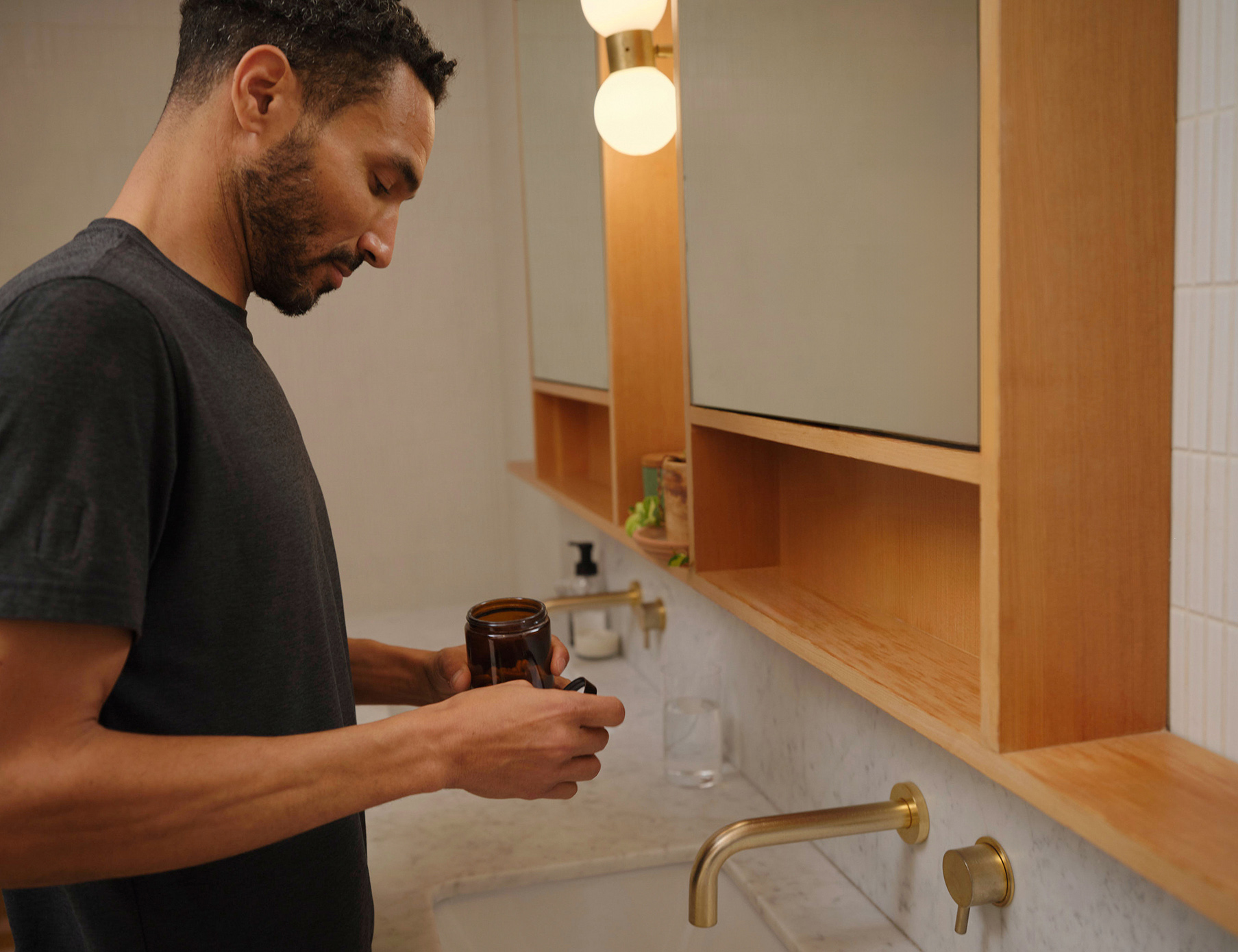Midlife is not the beginning of the end — it’s a critical window of opportunity. Yet far too many men dismiss warning signs like low energy, poor sleep, lack of drive, or declining performance.
“A lot of men assume it’s just normal aging. We’re taught to push through and not make a big deal out of things, especially when it’s not an obvious crisis,” says Lifeforce Physician Alex Antoniou, MD. ”But those small signs are often tied to hormone shifts, metabolic imbalances, or chronic inflammation. The good news is that most of this is highly treatable. You don’t have to just accept feeling worse every year.”
What you should accept: that the first step to optimizing your wellness is seeking support from your healthcare team. “There’s a myth that getting healthcare is not masculine. That’s not true,” says Lifeforce Clinician Jillian Chelson, MS, PA-C. “The ‘no pain, no gain’ mentality is not how you feel better as a man. That’s a cultural idea that we’re hoping to reverse.”
In honor of Men’s Health Month, our experts debunk more common myths about men’s health — and share what you should do instead to protect your strength, enhance your vitality, and add healthy years to your life.
Because taking your health seriously isn’t a weakness — it’s a strong strategy for longevity.
7 Men’s Health Myths Holding You Back
 1. The Myth: Testosterone decline starts in your 50s and 60s.
1. The Myth: Testosterone decline starts in your 50s and 60s.
The Truth: “Testosterone levels can actually begin dropping as early as the late 20s or 30s,” says Lifeforce Clinician Douglas Larner, NP. Starting in the mid-30s, men lose 1-2% of their testosterone each year, typically due to factors like chronic stress, sleep disruptions, poor diet, a sedentary lifestyle, and environmental toxins.
“This myth that testosterone drops later in life causes many younger men to overlook symptoms like fatigue, poor muscle recovery, and reduced libido, attributing them to stress or overwork instead of a hormonal imbalance,” Larner says.
If you’ve been feeling more tired, less focused and motivated, or your workouts aren’t as effective as they used to be, the first step is getting a comprehensive blood panel. Larner recommends testing for total and free testosterone, sex hormone binding globulin (SHBG), estradiol, LH, FSH, and DHEA. (These biomarkers are all included in the Lifeforce Diagnostic.) Larner suggests, “Ideally, consult a practitioner specializing in men’s health or hormone therapy, not just a generalist.”
Your Lifeforce team can help you determine if Testosterone Replacement Therapy (TRT) is right for you, and they can support you to increase your testosterone naturally by optimizing your workout routine, diet, and sleep quality.
“You can reverse and correct falling testosterone levels,” Chelson says. “Watch and wait is not the best practice.”
 2. The Myth: Erectile dysfunction is just about sex.
2. The Myth: Erectile dysfunction is just about sex.
The Truth: “Sexual function issues are often ignored because men are ashamed to bring them up with their doctors”, says Chelson. A study in the journal Nature found that only 22% of men experiencing erectile dysfunction (ED) reported discussing it with their physician, despite 82% wanting to raise the issue. The number one reason holding them back was embarrassment.
When men are silent, their sex lives may not be the only thing to suffer. “Erectile dysfunction can be the first sign of potential heart disease. It may be the first presenting symptom that a male’s vascular health is compromised,” Chelson warns. “When men think of sexual function change, they think it’s probably hormones, but 90% of the time it’s a vascular issue. It’s like the canary in the coal mine, but it often gets overlooked in healthcare.”
If you are experiencing changes in your sexual wellness, Chelson suggests consulting a physician to check all your biomarkers — both cardiovascular and hormonal. From there, you can treat underlying causes as needed.
Lifeforce also provides a safe and supportive space to talk to your clinician about pharmaceutical options to treat ED. For example, Lifeforce offers Tadalafil, which improves blood flow to the penile tissues. Research shows that low-dose Tadalafil can also improve coronary function and lower cardiovascular risks.
Whatever its cause, “ED is not necessary,” Chelson says. “I’ve seen men in their 80s who have no dysfunction, but 29-year-olds who already do. It’s not a normal stage of aging, and it does not have to happen.”
 3. The Myth: Heart disease only impacts seniors.
3. The Myth: Heart disease only impacts seniors.
The Truth: Many people know that heart disease is the leading cause of death in both men and women, but most don’t realize how early it can start. “If you ask the average person, they think that heart disease is for old people. It’s not,” Chelson says.
She notes that 50-55% of men in the United States have their first heart event before the age of 65. Another study found that one-third of people aged 15 to 20 who had an autopsy after dying by accident, homicide, or suicide already showed the beginning formation of plaque in their arteries. “We used to think coronary disease didn’t start until 50 or 60. Now we know better,” Chelson says.
Armed with this knowledge, Chelson suggests that everyone test for cardiac biomarkers such as HDL cholesterol, LDL cholesterol, ApoB, and Lipoprotein (a) as early as possible. (Lifeforce also offers a Cardiovascular Health Panel that measures even more advanced biomarkers.)
“We can optimize these biomarkers with lifestyle habits and nutraceuticals,” Chelson says. “There is also a subset of the population that it’s genetic, and we treat it with medication.”
 4. The Myth: Osteoporosis is a “women’s issue.”
4. The Myth: Osteoporosis is a “women’s issue.”
The Truth: While women are more commonly diagnosed with osteoporosis, especially post-menopause, men account for up 20% of osteoporosis cases, and approximately 1 in 5 men over 50 will break a bone due to osteoporosis, according to Larner. He also notes that men who sustain osteoporotic fractures have a higher mortality rate than women.
“Bone density is closely tied to estrogen levels and weight-bearing physical activity. Men typically continue producing estrogen through their 50s, 60s, and even 70s, which delays osteoporosis compared to women and contributes to the myth,” Dr. Antoniou explains. “But as hormone levels and muscle mass decline with age, so does bone density. Men should be thinking about this earlier — especially those who overtrained in competitive sports or did years of manual labor that stressed their joints.”
Both Dr. Antoniou and Larner suggest keeping bones strong with regular resistance training, optimal intake of nutrients such as vitamin D+K, calcium, and magnesium, and supporting hormones that regulate bone strength like testosterone. Chelson also advises getting a bone density DEXA scan, which are available in some gyms and wellness centers.
 5. The Myth: Snoring is harmless.
5. The Myth: Snoring is harmless.
The Truth: “Snoring is more than annoying — it disrupts oxygen flow and quality sleep, which are both essential for overall health and hormonal balance,” Larner says. He notes that snoring can be a red flag for sleep apnea, a condition linked to hypertension, cardiovascular disease, insulin resistance, cognitive decline, and low testosterone.
“One of the primary reasons men have low T is because they are not getting the deep sleep -slow wave and REM-they need to produce testosterone,” Chelson says. “Then from the minute they wake up, they’re exhausted.”
If you snore regularly, all our experts recommend consulting a sleep specialist for a sleep study and to explore if you need a CPAP machine to treat sleep apnea. (You can even start with an at-home test from a company like Lofta.)
“Sleep studies are easier and more accessible than ever, and they can be life-changing,” says Dr. Antoniou. “Good sleep is foundational — your energy, hormones, and focus all depend on it.”
 6. The Myth: Estrogen is the enemy.
6. The Myth: Estrogen is the enemy.
The Truth: “Men are afraid of estradiol,” Chelson says. “They think of it as a female hormone, but it’s not.” While estradiol is a form of estrogen that plays a crucial role in women’s reproductive health, it is also essential for men’s sexual function, cognition, and cardiovascular health.
“I’ve heard from some men that they hear from friends at the gym that they should block estradiol. Some even use a medication typically prescribed for hormone-sensitive breast cancer,” Chelson explains. “There is a very small subset of men who have breast development because of estradiol and need to block it, but for most men, estradiol is good for them. It contributes to libido, protects coronary arteries, and helps keep cholesterol and blood pressure lower.”
According to Chelson, the optimal estradiol range for most men is 10-40 pg/mL. Some young men and older men on testosterone therapy may have higher levels, but Chelson says clinicians typically do not try to lower it unless men are experiencing symptoms such as water retention, breast tissue growth, or mood swings. “This can happen in a small percentage of men,” she says. “If it does, we will treat it with a SERM-selective estrogen receptor modifier.”
 7. The Myth: You don’t need annual check-ups if you feel fine.
7. The Myth: You don’t need annual check-ups if you feel fine.
The Truth: Regular check-ups and continual biomarker testing are crucial not only to stay ahead of your health, but to reach new heights of wellness and performance.
“Men often wait until something breaks before asking for help,” Dr. Antoniou says. “Preventive care doesn’t always feel urgent, but when we frame it as proactive optimization, it resonates more. I actually see more men today than I did 20 years ago taking charge of their health.”
Ready to optimize your health? Start your Lifeforce Membership to get the data to understand your body, the experts to interpret it, and a personalized plan to help you feel your best.
This article was medically reviewed by:
Jillian Chelson, MS, PA-C, Board Certified in Family Medicine
Douglas Larner, NP, Institute for Functional Medicine Certified Practitioner, HRT, Peptide Certified Practitioner

